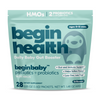How HMOs Bridge the Gap Between Formula-Fed and Breastfed Babies
share this article

The Nutritional Gap Between Breast Milk and Formula
Breast milk is widely considered the gold standard for infant nutrition—packed with immune-supporting compounds, living bacteria, and a dynamic nutrient profile that evolves with your baby’s needs. One of its most unique components? Human Milk Oligosaccharides (HMOs).
HMOs are the third most abundant solid component in breast milk (after lactose and fats), and they play a powerful role in shaping the infant gut microbiome, supporting immune development, and protecting against infection [1].
For years, infant formula lacked this key component—until now.
Thanks to advances in biotechnology, formulas can now be fortified with bioidentical HMOs, helping to bridge the biological gap between formula-fed and breastfed babies.
What Are HMOs?
Human Milk Oligosaccharides are specialized prebiotics that aren’t digestible by babies—but they’re critically important because they feed beneficial gut bacteria, especially Bifidobacterium infantis. In doing so, HMOs help establish a gut microbiome that’s closer to that of a breastfed infant.
More than 200 types of HMOs have been identified in breast milk. The most common and well-studied is 2’-fucosyllactose (2’-FL), which is now widely included in infant formulas.
The Science: How HMOs Help Close the Gap
Several studies show that adding HMOs like 2’-FL to infant formula can mimic many of the protective and developmental benefits of breast milk, especially in the gut and immune system:
1. Supports a Healthier Gut Microbiome
HMOs encourage the growth of beneficial gut bacteria—particularly Bifidobacteria—that are more commonly found in breastfed infants. In a clinical trial, infants fed formula with 2'-FL developed a gut microbial composition more similar to breastfed infants compared to those fed standard formula [2].
2. Reduces Risk of Infection
HMOs act as decoys that block pathogens like E. coli and Campylobacter from binding to the intestinal wall. One study found that formula with HMOs was linked to fewer respiratory and GI infections compared to traditional formula [3].
3. Promotes Immune System Maturity
HMOs support the development of the gut barrier and immune signaling. Since nearly 70% of the immune system resides in the gut, this early shaping helps reduce inflammation and build resilience.
Do HMOs Make Formula “Just Like Breast Milk”?
While HMOs bring formula closer to breast milk than ever before, it’s important to note: no formula can fully replicate human milk. Breast milk contains live immune cells, enzymes, and antibodies that formula doesn’t.
That said, formulas with HMOs narrow the gap—especially in the first few months when the gut microbiome and immune system are developing most rapidly.
HMOs allow formula-fed babies to benefit from one of breast milk’s most powerful features: microbiome support.
Where Else Can HMOs Be Used?
Beyond formula, HMOs are now being studied and used in supplements for babies, toddlers, and even adults. For example, Begin Health’s Growing Up Prebiotics includes 2’-FL HMO plus chicory root inulin—a unique combo that continues to support gut health in toddlers beyond infancy. This approach helps maintain a healthy gut ecosystem during the transition from breast/formula to solid foods.
Summary
HMOs are one of the most promising advances in infant formula nutrition. By mimicking key prebiotics in breast milk, they help support gut microbiome development, immunity, and digestive health in formula-fed babies.
While breast milk remains the gold standard, HMOs are helping to bridge the gap, giving more babies access to the foundational gut support they need to grow and thrive.
















